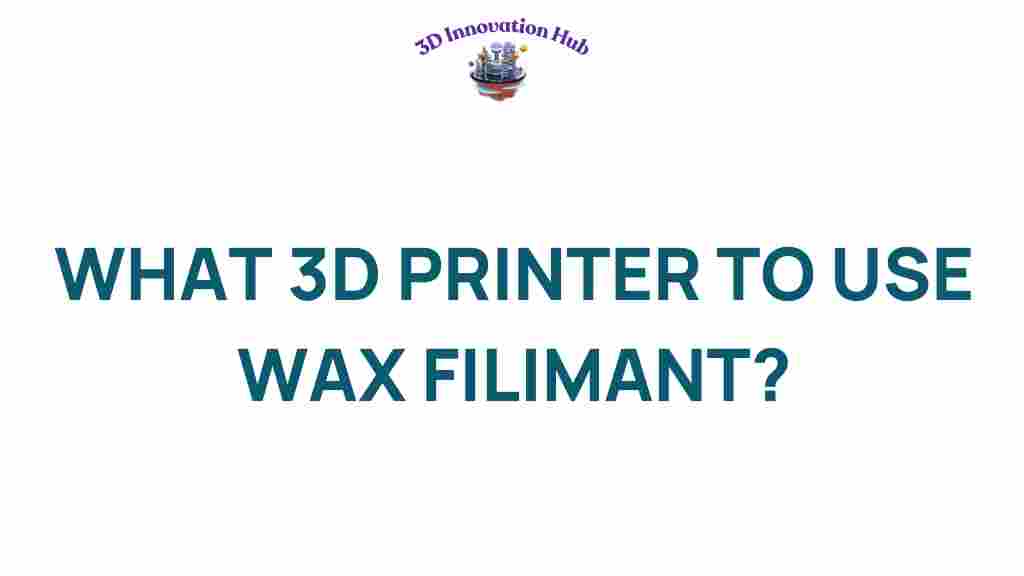Unveiling the Best 3D Printers for Wax Filament Masterpieces
In the realm of 3D printing, innovation and technology continue to evolve, allowing artists, designers, and manufacturers to create intricate masterpieces with unparalleled precision. One of the most exciting materials in the world of additive manufacturing is wax filament. This unique material is especially favored for its smooth finish and the ability to produce detailed designs ideal for sculpting, jewelry, and prototyping. In this article, we will explore the best 3D printers for working with wax filament, providing you with insights into the technology, features, and benefits of each model.
Understanding Wax Filament and Its Applications
Wax filament is a specialized type of material used in 3D printing that simulates the properties of traditional wax. It is widely used for:
- Sculpting: Artists can create intricate designs and sculptures that require fine details.
- Jewelry: Jewelers use wax prints to create prototypes for casting in metals.
- Prototyping: Designers can quickly iterate on their ideas with a material that captures the essence of the final product.
Due to its unique properties, wax filament is particularly useful for projects that demand high accuracy and smooth surface finishes. Let’s delve into the top 3D printers that excel in printing with wax filament.
The Best 3D Printers for Wax Filament
When selecting a 3D printer for wax filament, it’s crucial to consider factors such as print quality, ease of use, and material compatibility. Here are some of the best options available on the market:
1. Formlabs Form 3
The Formlabs Form 3 is a leading choice for professionals looking to create high-quality prints with wax filament. This 3D printer employs stereolithography (SLA) technology, which is perfect for achieving intricate details.
- Features:
- High-resolution printing up to 25 microns.
- Works seamlessly with Formlabs’ wax resin for jewelry prototyping.
- User-friendly interface and cloud-based printing.
- Benefits:
- Exceptional detail and surface finish.
- Reliable and consistent results.
- Great support for beginners and professionals alike.
For those serious about jewelry making, the Formlabs Form 3 is indeed a worthy investment. You can learn more about the Formlabs Form 3 here.
2. Anycubic Photon Mono X
The Anycubic Photon Mono X is another exceptional 3D printer that utilizes LCD resin printing technology. It is known for its large build volume and impressive print speed.
- Features:
- Build volume of 192 x 120 x 245 mm.
- Print resolution of 50 microns.
- Fast printing speeds, reducing overall production time.
- Benefits:
- Affordable price point for the quality offered.
- Easy to set up and operate.
- Compatible with various resin types, including wax.
This printer is perfect for those who want to create detailed prototypes quickly and efficiently.
3. Elegoo Mars 2 Pro
The Elegoo Mars 2 Pro is well-regarded for its affordability and high-quality prints. It is an excellent choice for hobbyists and professionals alike.
- Features:
- High resolution of 50 microns for fine details.
- User-friendly touchscreen interface.
- Durable build quality and reliable performance.
- Benefits:
- Budget-friendly option without compromising on quality.
- Great for beginners in additive manufacturing.
- Supports a variety of resins, including wax filament.
The Elegoo Mars 2 Pro is an excellent way to start your journey in 3D printing with wax filament.
Step-by-Step Process for 3D Printing with Wax Filament
Once you have selected the right 3D printer for wax filament, it’s essential to understand the process to achieve the best results. Follow these steps:
Step 1: Design Your Model
Begin by creating your design using CAD software. Ensure that the model is optimized for 3D printing and accounts for any necessary supports or overhangs.
Step 2: Prepare the Printer
Set up your 3D printer according to the manufacturer’s instructions. This includes:
- Loading the wax filament or resin.
- Calibrating the printer bed.
- Ensuring the printer is clean and free of debris.
Step 3: Slice the Model
Use slicing software to convert your 3D model into a format your printer can understand. Adjust settings such as layer height, print speed, and infill density to optimize for wax filament.
Step 4: Start the Print
Begin the printing process and monitor the initial layers to ensure proper adhesion. Most printers will have a display that shows the progress.
Step 5: Post-Processing
After printing, carefully remove the model from the build plate. Clean any excess material and cure the print if necessary. For wax models, you may also want to refine the surface with sanding or polishing.
Troubleshooting Common Issues in 3D Printing with Wax Filament
While 3D printing with wax filament can be rewarding, you may encounter some common issues. Here are some troubleshooting tips:
Problem 1: Poor Adhesion
If your prints are not adhering well to the build plate, try the following:
- Ensure the build plate is clean and leveled.
- Adjust the Z-axis offset to bring the nozzle closer to the plate.
Problem 2: Incomplete Prints
Sometimes prints may not complete due to various reasons:
- Check the filament for any blockages.
- Ensure your slicing settings are correct.
Problem 3: Surface Imperfections
To avoid surface imperfections:
- Use the correct print speed and layer height settings.
- Consider post-processing techniques like sanding if necessary.
Conclusion
Choosing the right 3D printer for wax filament is crucial for producing stunning masterpieces. Whether you are sculpting, prototyping, or designing intricate jewelry, the options listed above provide excellent quality and reliability. As technology and innovation in additive manufacturing continue to advance, the possibilities for creativity and design are limitless. Dive into the world of 3D printing with wax filament and unlock your potential for creating beautiful, detailed works of art.
For more information on 3D printing technologies and innovations, visit this resource.
This article is in the category and created by 3D Innovation Hub Team
